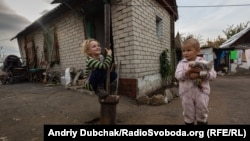As tensions continue to mount between Russia and Ukraine, an unexplained explosion in eastern Ukraine’s Donbas region has put a little boy called Vladik at the center of the two countries’ raging information war.
On April 2, the five-year-old – identified by media as both Vladik Dmitriyev and Vladik Shikhov -- died from “blast trauma and multiple shrapnel wounds” in the separatist-controlled village of Oleksandrivske, 47 kilometers (about 30 miles) to the northeast of Donetsk, the main city in the self-declared Donetsk People’s Republic, the Organization for Security and Cooperation in Europe’s Special Monitoring Mission reported. The site is about 15 kilometers (about 9.3 miles) away from Ukrainian army positions.
Both the OSCE and the UN refugee agency UNHCR investigated the incident, but neither has identified what specifically caused the boy’s death outside of his paternal grandparents’ home.
That has not prevented Russia’s pro-Kremlin media from asserting that a bomb-carrying, Ukrainian military drone was to blame. The allegations surfaced at a moment when both countries are striving to show the international community – and their own populations -- that the other plans a full-scale war over the Donbas conflict zone.
“Ukraine is using a CIA tactic: It’s sending out drones with bombs,” declared the state-owned Rossia 24 in an April 4 report. “One of them fell straight into the courtyard of a residential building in Donetsk [Oblast]. A five-year-old child died.”
Other such mainstream outlets have featured similar reports, with the daily Komsomolskaya Pravda on April 6 lamenting Ukraine’s alleged killing of children in the Donbas conflict zone.
Two teenagers were also reported to have died from mines that day in a separatist-controlled part of the Luhansk region.
Following these reports, State Duma Chairman Vyacheslav Volodin, a close ally of Russian President Vladimir Putin, urged a discussion about Ukraine’s potential expulsion from the Council of Europe, the continent’s chief human-rights organization, and also called on the Parliamentary Assemblies of the OSCE and Council of Europe to press Kyiv for answers about Vladik’s death.
Referring to the United States and European Union, Volodin has claimed that the supposed drone strike against Oleksandrivske occurred with the “consent” of Ukraine’s “overseas patrons” and “the European states’ tacit approval."
Both Russia’s Investigative Committee, its primary body for criminal investigations, and Donetsk separatists are conducting inquiries into the blast, which de facto Donetsk officials have termed a terrorist act.
To date, though, no physical or concrete proof of a Ukrainian drone’s involvement in the explosion that killed Vladik has been presented. Oleksandrivske’s location is considered beyond the range of ordinary drones.
Terming the accusations “fake news,” the Ukrainian Defense Ministry denounced the allegations against the Ukrainian army as “a gross, cynical, nasty and godless manipulation,” Agence France-Presse reported.
The spokesman for the Ukrainian delegation to talks on the Donbas conflict, Oleksiy Arestovych, blamed Vladik’s death on “an explosive device” that Russia “scatters” in the area, Ukraine’s Hromadske (Public) Radio reported. Arestovych denied that the Ukrainian army uses drones in Donbas.
Putin spokesman Dmitry Peskov has conceded that he does not have “verified information” about the child’s death outside of his grandparents’ house, but added that he also does not have reason “to doubt the truthfulness of the information” released by Donetsk and its ally, the self-declared Luhansk People’s Republic.
“Of course, it’s difficult to imagine that it’s possible to create fake news around the death of a child,” Peskov concluded.
But that is exactly what the Kyiv-based media watchdog Stopfake claims Russian mass media outlets are doing.
After conducting its own investigation, the journalists-run organization charged on April 4 that the account about a Ukrainian drone killing the boy appeared to be an invention.
On the Russian social network VKontakte (In Contact), it reported, users allegedly from the Donetsk area discussed the likelihood of an accident, such as the boy playing with a souvenir grenade.
In an interview with Russian rights activist and journalist Oksana Chelysheva, the boy’s father, Sergei Shikhov, stated that his son had run outdoors to play just before the blast occurred. He denied that the residence contains any leftover explosives from the 2014-2015 Donbas war.
Shikhov stated that no drone had been seen at the site, but that his mother’s friends, who live at a higher elevation, told them that they had heard a drone before the explosion.
OSCE monitors who visited the site hypothesized that damage to the house was
“probably caused by shrapnel.” The boy’s grandmother sustained minor injuries from the blast.
Several kilometers to the southwest of the residence, the monitors found a 20-centimeters-wide crater and holes in gates, a wooden shed, and two metal water tanks.
On April 2, the day of Vladik’s death, the OSCE Special Monitoring Mission recorded 52 explosions in the Donetsk region, primarily northeast or south of the city of Donetsk – roughly double for the preceding month. Overall, 225 ceasefire violations were registered, compared with just one the day before.
In the rush to denounce the opposing side for Vladik’s death, Ukrainian and Russian media do not appear to have analyzed these details.
To international relations expert Ilya Kusa, an analyst at the non-governmental Ukrainian Institute of the Future, media allegations about the blast resemble the “information-psychological operations” that usually accompany military or political “aggression” – tactics that can be used by either Ukraine or Russia, he stressed.
In Russia, the aim could be to rally voters to support President Vladimir Putin in a parliamentary election year by focusing on an external enemy, Kusa posited. In Ukraine, he said, the information could be used by “nationalist patriots” who criticize the government as “indecisive” or who want to undercut Ukrainians who advocate a Donbas peace deal without fighting.
For Vladik’s parents, however, what matters most is establishing the truth about what caused the death of their son and punishing those responsible.
“Our children didn’t start the war,” wrote Vladik’s mother, Yekaterina Dmitriyeva, in a Facebook message shared by journalist Chelysheva. “They’re not guilty.”
-With additional reporting from TASS







Facebook Forum